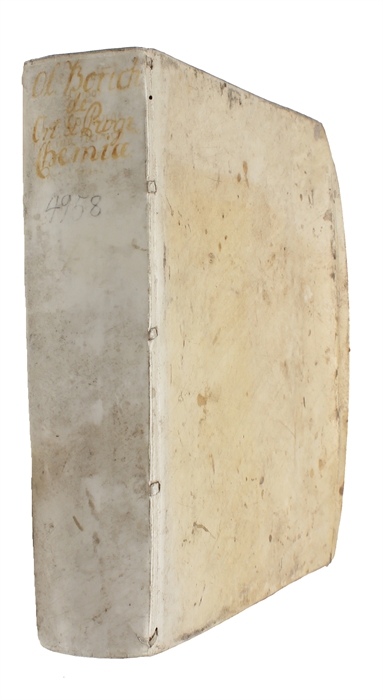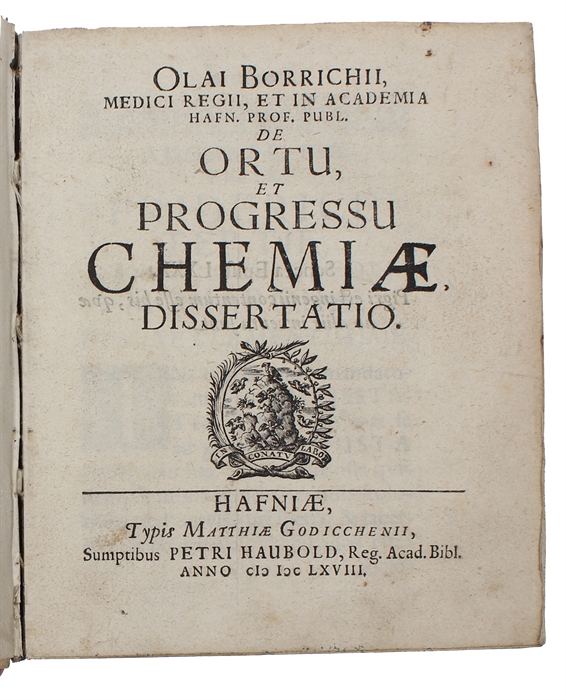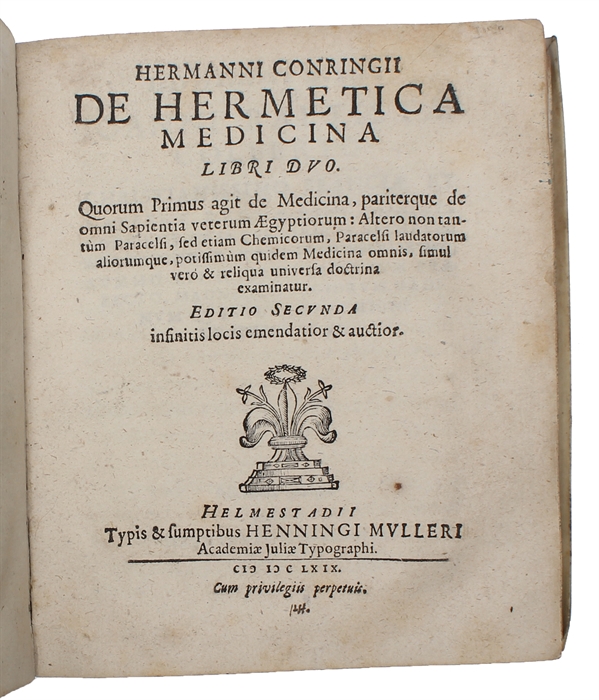THE FAMOUS BORCH-CONRING FEUD ON HERMETICA
CONRING, HERMANN (+) BORRICHUS, OLAUS (OLE BORCH)
De hermetica medicina libri duo (Conring) (+) De Ortu, et Progressu Chemiæ Dissertatio (Borch).
Helmstedt, H. Muller, 1669 (De Hermetica) & Copenhagen, Matthias Godiche for Peder Haubold, 1668 (De Ortu).
4to. In contemporary vellum over wooden boards. Title in contemporary hand to spine. Extremities with soiling and some marks and dots. Vellum gapping at the outer edge of the front board, partly detaching and showing the underlying wooden board. Light occassional discolouration throughout, stain to upper outer margin, not affeting text. Last leaf detached. [De Ortu...:] (14), 150, (2) pp.; [De Hermetica...:] (24), 447, (51) pp.
A highly interesting sammelband consisting of two rare works: the first edition of Danish scientist and physician Ole Borch’s “De Ortu, et Progressu Chemiæ” (1668), and the second edition of Hermann Conring’s “De hermetica medicina”, published as a reply and refutation of Borch’s work. The two works here presented in one binding are both interesting and important in their own right; together they constitute a fascinating glimpse into 17th century debates and science relating to hermetica. The Lutheran professor Hermann Conring (1606-1681) was one of the most important exponents of Galenic medicine and institutional Aristotelianism as practiced in the middle of the seventeenth century His perhaps most famous work, “De Hermetica Aegyptiorum vetere et Paracelsicorum nova medicina” (1648), provides a series of accounts of debates on the magical power of plants, which, according to Conring, a convinced anti-alchemist and anti-Paracelsian, belonged to the realm of poetry, not to nature. This claim quickly provoked a reply (here offered) by Ole Borch (1626-1690), Danish physician, chemist, and polyhistor, who was much more inclined to Paracelsism and Hermeticism. It gave rise to several controversies, all concerned with Hermes Trismegistus and the works attributed to him. Conring’s and Borch’s standpoints were wide apart. For Borch for instance, chemistry was an age old discipline going back to pre-diluvian Tubalcain, originating in Egypt and then passing on to Greece, whereas Conring followed the tradition according to which Moses had introduced this discipline in Egypt. Borch, for his part, believed Moses to have received his knowledge in Egypt from none other than Hermes Trismegistus. It is obvious that these standpoints also influenced Conring’s and Borch’s interpretations of Homer's and Hermes' herb theories and expositions. “In 1668 Borch initiated a controversy in his dissertation De ortu et progressu chemiae. In 1669 Conring reacted with a second edition of his Hermetica medicina, published under a slightly different title and complete with an apologeticus addressing Borch. Listing Orpheus, Pythagoras, Empedocles, and many others said to have excelled in “magical medicine” (magica medicina), Conring also mentions Homer and his famous moly. Homer’s familiarity with magical arts, Conring says, is brought out by the Odyssey. As Pliny said, magical arts were the origin of the poet’s works. Though Conring does not doubt the power of moly, he argues, this power does not work through magic, since healing wounds or alike through incantations is magical. This last point is doubted by Conring. A few lines later he also makes it clear that a “magical power” (magica vis) attributed to a plant by some magi or idolaters cannot be considered natural (naturalis vis). Since moly belongs to magic in Homer’s poetry, it must be interpreted as part of poetical fiction, Conring argues. It is a magical plant, regardless of how inaccurate this might seem from the point of view of natural sciences. Considering the presence of incantations in the Homeric passage, identifying moly with a real-world plant is more than questionable.” "Ole Borch did not agree. Since 1660 he was a professor extraordinarius lecturing in a very practice-oriented way not only on botany and chemistry, but also on poetics. Borch’s extensive output in the field of poetics was well received even beyond the university of Copenhagen. In his reply, he urges Conring to stop trying to impose views that had not been verified. According to Borch, physicians of the past have shown that plants may legitimately (legitime) defeat diseases induced by incantation. Physicians and astronomers, such as the Paracelsian Bartholomaeus Carrichter, had stated that black hellebore or hypericum seemed most efficient especially as regards diseases of the mind. There is no reason, says Borch, to attribute simple superstitio to Homer. Has the commentary tradition not shown that moly being “difficult to extract for mortals but not for gods” could also mean it being simply hard to find? Indeed, is it not hard to find most of these plants which are reported to be most effective against mental diseases? Galen himself had stated it on several occasions. The true nature of moly aside, while the practices and ceremonies described by the poet were, of course, superstitious, the thing (res), i.e. the plant, must have worked in a natural way (naturaliter)?” (Wallura, HERMES' HERB: Homer’s moly and Early Modern Iatrophilology) The feud between Borch and Conring testifies to the strong and prominent role that hermetic and Paracelsian ideas played in the scientific and philosophical debate in 17th century Europe. Duveen 89 ("celebrated treatise")
Borch’s ”De Ortu, et Progressu Chemiæ” was published as a reply to Conring’s “De Hermetica Aegyptiorum” (1648). Conring in turn expanded his “De Hermetica Aegyptiorum” to function as a critical comment to Borch’s “De Ortu” and published it in 1669 under the different title “De hermetica medicina libri duo”
Ferguson I, 119
Waller 15422
Wellcome II, 206
Order-nr.: 60763



